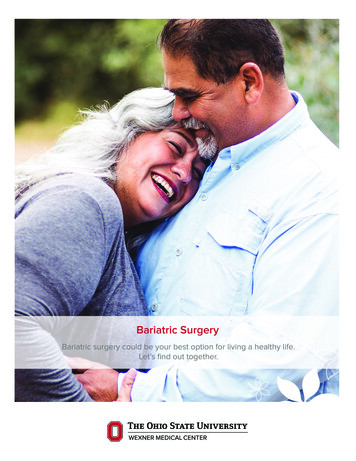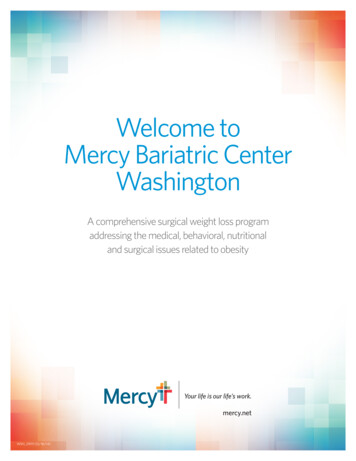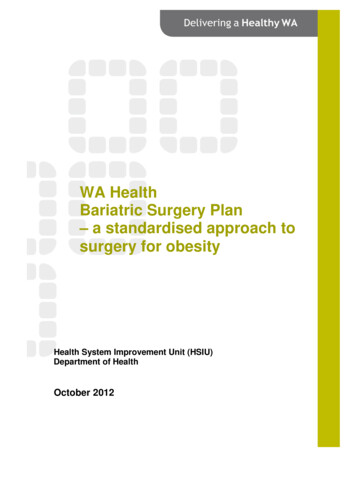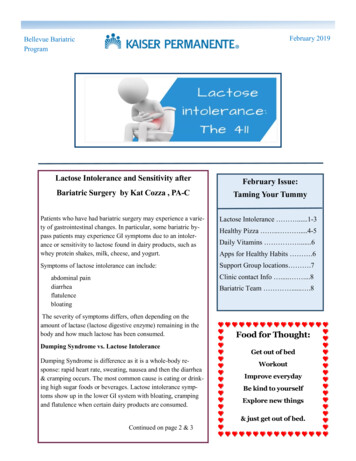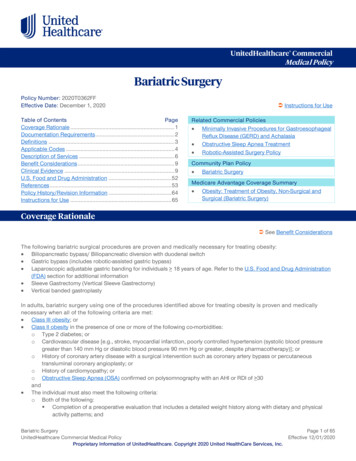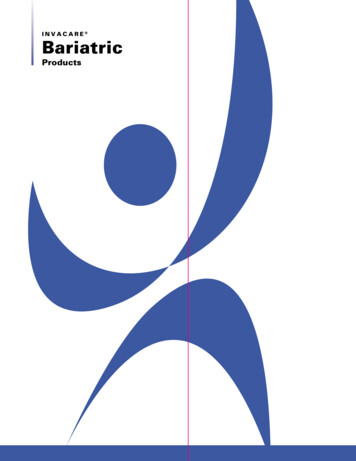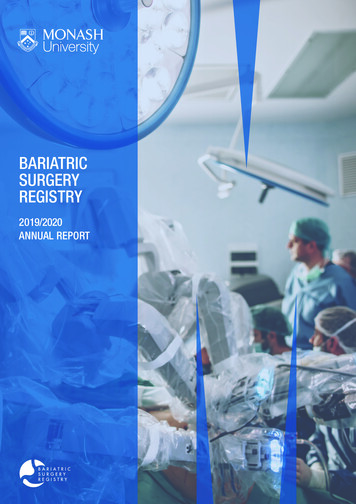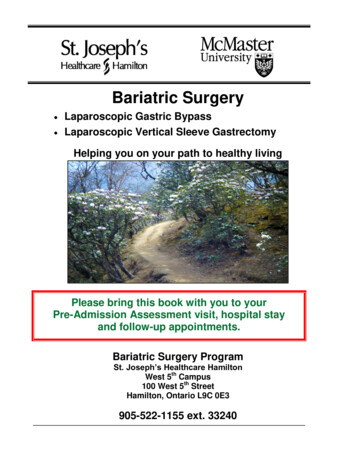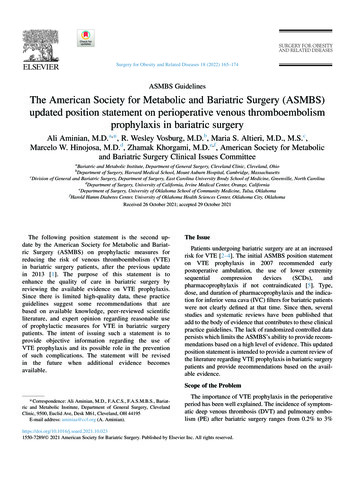
Transcription
Support Group NewsletterFall, 2016In the NewsAs reported in HealthDay News, 7/15/16 –Obese and overweight moms seem to serve theirkids more food at meals, potentially boosting theirrisk for childhood obesity.University of Florida researchers asked mothers todescribe their level of hunger and that of their 3- to6-year-olds before meals. Twenty-nine childrentook part in the study.Women who were overweight or obese reportedfeeling hungrier and thought their kids werehungrier, too. Then, they gave them biggerportions.“Because young children have difficultyrecognizing when they are full, the more food theyare presented at mealtime, the more they are likelyto eat,” lead investigator Sarah Stromberg said in auniversity news release. Stromberg is a doctoralstudent in the Department of Clinical and HealthPsychology.Study senior author David Janicke, a professor ofclinical and health psychology, said, “If we canstart to identify those factors, we might be able tointervene to help parents develop more appropriateportion sizes for younger kids, which hopefullycan lead to a longer life of healthy eating habits.”The researchers noted that the findings arepreliminary, because the study was small.“This study was a good starting point, andultimately if we’re able to see these findingsreplicated we can intervene with knowledge,awareness and strategies to help parents and kidsJFK FOR LIFE is pleased to welcome Dr.Aram Jawed who recently joined the practice ofDr. Alexander Abkin at Advanced LaparoscopicSurgeons of Morris.Dr. Jawed is a well-trained surgeon specializing inadvanced laparoscopic, bariatric and roboticsurgery. He recently completed a minimallyinvasive, bariatric and robotic surgical trainingfellowship at Innovation Health in northernVirginia.He is a member of the American MedicalAssociation (AMA), American College of Surgeons(ACS), and the Society of American Gastrointestinaland Endoscopic Surgeons (SAGES). Proceduresperformed include Laparoscopic Gastric Bypass,Laparoscopic Sleeve Gastrectomy, LaparoscopicRevision of Gastric Bypass, Surgery for GERD,Laparoscopic Gall Bladder Removal and othergeneral laparoscopic procedures.We are very delighted to have Dr. Jawed aboard!Support Group Newsletter 1
work together to limit how much kids are beingserved,” Janicke said.Meanwhile, how can parents make sure their kidsdon’t eat to excess?“Parents decide what to serve their kids and when,but kids still should have a reasonable amount ofcontrol over how much they eat,” Janicke said. “Ifkids eat an appropriate serving size and are stillhungry, they can ask for more.”The study appeared in the June issue of theJournal of Human Nutrition and Dietetics.From Your Weight Matters – Obesity ActionCommittee (OAC) Update:At the 2016 Your Weight Matters NationalConvention hosted recently in Washington, DC,OAC Chairwoman Amber Huett-Garcia sharedwith a diverse audience about the OAC’s five yeargoals to guide the organization through the year2021. She also discussed one of the OAC’s veryfirst initiatives to achieve one of these goals:reduce the existence of weight bias by 10percent in today’s society.members, supporters and volunteers— that we arepublicly releasing the news about this NationalInitiative, and we’re excited to take the next steptoward combating weight bias in the media and inthe public eye. The OAC image gallery is our allnew bias-free, non-commercial image gallery thataims to provide the right kind of images to beused in the media, in public and everywherewhere individuals with obesity are portrayed.These images are also entirely free, and uponcompletion there will be almost 4,000 of them tochoose from.However, to achieve our goals and to progressfurther in reducing weight bias, we need thesupport of the OAC community. We ask that youshare this project with your family, your friends,local newspapers and social media, and let themknow that our image gallery is free and availableto the public.Want more information about the OAC and howyou can join?Earlier in the year, we announced that the OACwould be releasing a brand new, Nationalinitiative to build an online library of stockimages showcasing people with obesity in apositive light. If you research obesity, or read anystory about obesity in today’s media, a verycommon theme exists among almost all of thepictures representing this disease: the subjectshave no heads, or they’re eating food in ananimated way. Perhaps they’re standing on atilting scale, or only certain parts of their body arehighlighted.The OAC recognizes that these images whichaccompany stories and articles about obesity arenot only stigmatizing and degrading, but they area form of bias. They dehumanize the individualaffected by obesity, and do nothing to representwhat someone with obesity really looks like.Now, we’re excited to share with you — ourSupport Group Newsletter 2
CalendarSUPPORT GROUP MEETINGWEDNESDAY, OCTOBER 12TH 6:30PMNEW PATIENT SEMINARTUESDAY, OCTOBER 18TH 7PMCALL 732-744-5955 TO REGISTERSUPPORT GROUP MEETINGTHURSDAY, OCTOBER 20TH 6:30PMOCTOBER 31ST –HALLOWEENNOVEMBER 4TH – KING TUT DAYKing Tut Day celebrates the date of the discovery of KingTutankhamen's Tomb in 1922.DAYLIGHT SAVINGS TIME ENDSNOVEMBER 6TH 2AMSUPPORT GROUP MEETINGWEDNESDAY, NOVEMBER 9TH 6:30PMNEW PATIENT SEMINARTUESDAY, NOVEMBER 15TH 7PMCALL 732-744-5955 TO REGISTERSUPPORT GROUP MEETINGTHURSDAY, NOVEMBER 17TH 6:30PMSupport Group Newsletter 3
Perfect for the SeasonFrom the desk of Kelly DiFabio, RDHere is a tasty recipe to pull the essence of autumn together in dish!Slow Cooker Black Bean, Butternut Squash & Quinoa ChiliAuthor: Gena Hamshaw Published on: thefullhelping.comPrep time: 15 mins. Cook time: 6 hours, Total time: 6 hours 15 minsServes: 10-12 servingsIngredientsFor the chili: 2 teaspoons olive oil 1 large white or yellow onion, diced 2 stalks celery, diced 3 cloves garlic, diced 2 tablespoons tomato paste 1½ tablespoons chipotle en adobo (about 1 pepper and juices), finely chopped 2 teaspoons chili powder 1 teaspoon cumin 1 teaspoon coriander ½ teaspoon smoked paprika ½ teaspoon cinnamon ¾ teaspoon salt (or to taste) Pinch cayenne pepper (to taste) 3 cups low sodium vegetable broth or water 3 cups cooked black beans (or 2 cans, drained and rinsed) 1 - 1¼ pounds peeled, cubed butternut squash (about 1 small squash) 1 14 or 15-ounce can fire-roasted, diced tomatoes (don't drain) 1 cup dry quinoa, rinsed under running water in a fine sieve for about a minute Optional toppings: Tofu sour cream (below), chopped green or red onions, chopped parsley, choppedcilantro, avocado slices, guacamole, hot sauceSupport Group Newsletter 4
For the tofu sour cream: 8 ounces silken tofu 2 teaspoons olive oil 2 tablespoons lime juice 2 teaspoons rice vinegar or white wine vinegar ¾ teaspoon saltInstructions1.To make the tofu sour cream, simply place all ingredients in a blender or a food processor and blendtill smooth.2.For the most flavorful chili results, heat the olive oil in a large sauté pan over medium heat. Add theonions and celery and a pinch of salt, to get the onions sweating. Sauté for about 5 minutes, or until theonions are soft and clear. Add the garlic and cook for about 1 minute, stirring frequently. Add ¼ cup water,the tomato paste, the chipotle en adobo, the chili powder, cumin, coriander, smoked paprika, cinnamon, salt,and cayenne. Allow it to cook for one more minute, stirring to incorporate all of the ingredients.3.Add the broth, black beans, squash, diced tomatoes and their juices, and quinoa to your slow cooker.Add the cooked onion, garlic, and spice mixture. Stir everything to combine well. Cook on low heat for 6hours. Before serving, give the chili a good stir and add some additional vegetable broth if you'd like it to beless thick. Taste, adjust seasonings, and serve with toppings of choice.4.Alternately, you can simply add all of the ingredients to the slow cooker and cook for 6 hours onlow. If you have the time, browning the onions and garlic will give you most flavor.Per 4 ounce serving – Protein: 8g (with tofu 10g), Carbohydrate: 18g, Fiber 5g, Fat : 3gSupport Group Newsletter 5
Lemon Chicken with ThymeB12 DeficiencyAre You At Risk?Created by: eat-yourself-skinny.comVitamin B12 is a nutrient that helps keep thebody's nerve and blood cells healthy. VitaminB12 also helps prevent a type of anemiacalled megaloblastic anemia that makespeople tired and weak.Vitamin B-12*This recipe is an excellent source ofDietary sources of Vitamin B12 come fromanimal protein sources, including meat,poultry, fish, dairy products, and eggs.Patients having a sleeve gastrectomy orgastric bypass cannot consume enough foodto meet their needs for Vitamin B12. Andgastric bypass patients cannot absorb itproperly.Early signs of vitamin B12 deficiency includefatigue, weakness, diarrhea, dizziness, rapidheart beat, poor appetite, anemia, sore orswollen tongue, numbness and tinglingsensations. Prolonged B12 deficiency cancause permanent nerve damage, dementia,psychosis, altered mood, spasticity andmemory loss. If you experience any of thesesymptoms, contact your health care providerright away.Because the liver can store B12, you may notshow signs of a deficiency for several yearsafter surgery.Ask your healthcare provider or registereddietician how much vitamin B12 you shouldbe taking.Serves: 4 servingsIngredients 3 or 4 chicken breasts Juice of 2 lemons Zest of one lemon 2 cloves garlic, minced 1 Tbsp fresh thyme 1 tsp. pepper ½ tsp. sea saltInstructions1.Preheat oven to 375 degrees F.2.Whisk together lemon juice,lemon zest, garlic, thyme, salt andpepper; set aside.3.Place chicken breasts in a bakingdish and pour mixture over top,making sure to completely coat them.4.Bake for about 40 minutes(depending on size of chicken) untiljuices run clear. Enjoy!Nutritional InformationRemember Always take vitamins as prescribed andattend follow-up visits to review lab work.Taking vitamin supplements is required lifelong after any weight loss surgicalprocedure.Serving Size: 1 chicken breast Calories: 150 Fat: 4 g Carbs: 2.4 g Fiber: 0.08 g Protein: 25 gSupport Group Newsletter 6
These members celebrated their 1year SURGI-VERSARY since ourlast issue!TG ES JG AL AS DR SB JBDA TV LG EW DP AB CPMK ST SSTogether they have lost1, 600 pounds!October is Breast CancerAwareness Month which is an annualcampaign to increase awareness of the disease.While most people are aware of breast cancer,many forget to take the steps to have a plan todetect the disease in its early stages andencourage others to do the same. When breastcancer is detected early, and is in the localizedstage, the 5-year relative survival rate is100%.Kelly’s Hours Have Changed!Special Kudos to our members whocelebrated 2nd and 3rd yearanniversaries!FS JW RA LJ AMUP CE MD TK RBTogether they have maintained aweight loss of . . . . 979pounds!And to DK who after 5 years hasmaintained a weight loss of 110pounds!! WOWKelly DiFabio, RD is in the JFK for Lifeoffice in Edison on the following days:Wednesdays 9:30am – 6:00pm *Thursdays 11:00am – 7:30pm*2nd Wednesday 9:30am – 7:30pmSecond Wednesday of each monthis Support Group.If you wish to see Kelly to purchaseprotein or other supplements, it is best tocall before stopping by.Support Group Newsletter 7
Day HikingHiking is an excellent low-impact workout. Foradults, regular aerobic exercise like hiking hasmany benefits: Improved cardio-respiratory fitness (heart,lungs, blood vessels) Improved muscular fitness Lower risk of coronary heart disease andstroke Lower risk of high blood pressure and type2 diabetes Lower risk of high cholesterol andtriglycerides Lower risk of colon and breastcancer, and possibly lung and endometrialcancer Increased bone density or a slower loss ofdensity Reduced depression and betterquality sleep Lower risk of early death (If you are activefor 7 hours a week, your risk of dying earlyis 40% lower than someone active for lessthan 30 minutes a week.) Weight control; hiking burns up 370calories an hour (154-lb person)Hiking exercises almost every part of your bodyincluding your mind. Studies have shown thatwalking in nature can lead to a lower risk ofdepression. Being in nature, away from our busylives and technology, can allow you to connect tonature in a way that brings about a sense of peaceand well-being.Tips for the BeginnerDecide how long you have to hike. If you are ahiking novice, your first experience will not be onthe Appalachian Trail. Start with hiking a trail thatcan be done in less than a day that doesn’t requirea tent. Pick a hike based on how much time youhave. Do you have an entire Sunday or just aSaturday Afternoon?Pick your hiking location. Go to Trails.com andenter your zip code. The skill level, length andduration of each trail is provided. You can alsoask co-workers, friends and neighbors for traillocations.Let someone else know. If you do go out alone letsomeone know where you are going and what timeyou expect to be back. Make sure to bring yourcharged cell phone.Wear appropriate clothing. Long pants arepreferred especially if you are predisposed topoison ivy. Wear light weight shirts that wickaway moisture. Bring a waterproof jacket or windbreaker. You can easily get sunburn on the back ofyour neck while hiking – wear a hat! Invest in agood pair of hiking boots. Wear sunglasses.Water. Do not leave home without a waterbottle! Make sure you bring enough water withyou to keep you hydrated through your adventure –a liter or two should be sufficient. Make sure youhave been consuming water before you go hikingso that you’re not starting at a hydration deficit.Bring Snacks. Nuts and a piece or two of fruitCheck for ticks. If you are in a heavily woodedarea, check yourself for ticks. Make sure you takea shower with hot water and soap immediatelywhen you get home in case you came in contactwith any poisonous plants or things like that.Bring out what you bring in. Don’t leave trash inthe woods and pick up any trash you may see. Bea good steward of our planet!Bring a camera. You never know what you mightsee!Just in case – Bug spray and a first aid kit.Don’t hike alone. Hike with a friend or significantother. Another option is to find a local hikinggroup or club.Support Group Newsletter 8
The following article is taken from TheObesityHelp Online Newsletter, August 22, 2016 Overcoming Gym PhobiaThere are many reasons for not joining a gym orfitness center – lack of money, time, and energy –but these are often excuses for the real reason thatis common among those with obesity.Fear #1 – The gym environment intimidates me.If walking into a gym and seeing a sea of machinesgives you anxiety, you are not alone. There issomething extremely overwhelming about seeingendless rows of equipment filling a brightly litroom.Luckily, this is not your only option. If you are awoman, there are women-only facilities. You canalso look for hospital based fitness centers or oneat a recreational center. These locations have atendency to be more intimate and less intimidating.Fear #2 - I don’t know what to do at the gym.Whether it’s a large gym or a personal trainingstudio, try to learn everything you can about whatthe place has to offer. The more you know aboutwhat is available to you, the more empowered youwill feel when you step into the gym.Many gyms offer free initial sessions with apersonal trainer who can teach you how to use theequipment. Once you understand how to properlyuse the gym equipment, cut out further ambiguityby making a specific plan as to what you willspecifically do when you come to the gym.Fear #3 – I don’t like exercising alone.While the easiest solution to this problem is toexercise with a friend, we all know that despite thebest of intentions, this arrangement often fallsthrough.regulars are. With time, you may end upbefriending these individuals and before you knowit, you may end up being one of the regularsyourself.Fear #4 - I can’t keep up with everyone else.Personal fitness is not a competition unless youcount competing against your personal bests.When you try to learn a new sport, you don’texpect to play at a professional level by yoursecond week, so why would you set thatexpectation for yourself at the gym? Do notcompare yourself to others -- live your reality andallow yourself to progress at a pace that works foryou.Fear #5 - I feel embarrassed to go to the gym.After hours of positive self-talk, you finallyconvinced yourself to go to the gym. You dress athome to avoid locker room gawkers. As you steponto the gym floor, your eyes pan across a crowdof would-be fitness models. Your heart sinks andthe nerves kick in. It’s hard to feel like people arenot judging you as you step onto the treadmill.Don’t waste your energy on worrying about whatothers think -- you’ll need that energy for yourbicep curls. Also, keep in mind that skinny doesnot necessarily equal healthy. Reality check: a thinperson may actually be less fit than you. Not onlythat, they may actually feel just as self-consciousand out of place as you do. “When your life flashes before your eyes, makesure you’ve got plenty to watch.”This is where group fitness can play a role. Afteryou join a group fitness class and commit tocoming weekly, you’ll quickly notice who theSupport Group Newsletter 9 Unknown
Parts of this story were originally from Woman’sHealth at NBC News.comWhy Do I Still See Myself as Fat?While many people are thrilled when they loseexcess weight, not everyone is as happy as theyexpected to be.Body-image experts say it’s not uncommon forpeople, especially women, who have lost a lot ofweight to be disappointed to some extent todiscover that they still aren’t “perfect.” The excessfat is gone when they reach their goal weight, butthey may have sagging skin, cellulite or a bodyshape that they still deem undesirable. Some evencontinue to see themselves as though they areoverweight.Some specialists use the term “phantom fat” torefer to this phenomenon of feeling fat andunacceptable after weight loss.Some people who were formerly overweight oftenstill carry that internal image with them and seethemselves as still living in a large body. Expertssuspect this may happen because the brain hasn’t“caught up” with the new, leaner body, particularlyfor people who were obese for many years andthen experienced rapid weight loss. Body image isa lot harder to change than the physical body.Experts say part of the problem in our bodyobsessed culture is that many women — andincreasingly more men — have highly unrealisticexpectations of what weight loss can do for them.Too often, they think hitting their ideal weight willmake them look like a swimsuit model in amagazine, and they’re disappointed when that’snot the case.Some people will adjust naturally and morequickly to the weight loss than others, experts say.But it’s time to get help when people areexperiencing significant distress, sadness ordepression, they say, or their feelings areinterfering significantly with their normal activities(such as not going to parties or children’s events,always looking in the mirror or avoiding intimacywith a partner).Understanding that you have been reinforcing thisnegative image for probably a long time is a majorfirst step. Counseling may involve challengingdistorted ways of thinking about one’s appearance(by studying before-and-after photos, for instance,or bringing out the “fat pants” and seeing thedifference in the mirror), learning how to thinkabout oneself in a more positive manner, andworking to engage in activities one’s beenavoiding. From the desk of Karen Rose, LCSW .“Staying healthy with little time andeffort is possible. If I don’t make timenow to look after my health, I will beforced to make time later to take care ofmy sickness.” UnknownSolve the Cryptoquote!Each letter stands for another:Y TSSQ WYFTC YUQ Y WSUTJWRRG YBR ECR EDS ZRJEMFBRJ KSB YUHECOUT. OBOJC GBSIRBZSupport Group Newsletter 10
Food and Sugar AddictionDo you have difficulty controlling your intake ofsugary, high fat, or processed foods? Do you goout of your way to obtain certain foods or eat untilstuffed? Do you ever avoid social or workobligations due to having overeaten, or fear ofovereating? If so, you are not alone.Brain and behavioral research continue to supportthe fact that food absolutely can be addictive andcan look similar to alcohol or drug addiction.People who describe themselves as “food addicts”often decide that total abstinence from a particularfood or food group is the only answer to theirproblem. For many this may work. But for othersit is impossible or burdensome. But there are otheroptions.There is a lot of evidence that cognitivebehavioral, mindfulness, and acceptance-basedtherapies effectively treat conditions such as stresseating, binge eating and food addiction.Addictive food behaviors often stem from the factthat our brains have learned a way to cope withparticular circumstances to provide short-termrelief, but this coping method is ultimately nothelpful long-term. But like any unhealthy behavior,we can learn to replace it with new and betterbehaviors.6 Tips for Reducing Food and/or Sugar Addiction:1.Improved your food environment.Make sure you have healthy food options athome and minimize the high sugar andhigh-fat foods you bring into your home.This does not mean these foods are “bad”or “off-limits” but especially since you areat the beginning of your journey withmaking peace with food, you may find thatkeeping them out of the home will makethe process easier for you, and your brain.If you really want ice cream, make a planwith a loved one to go get it, and trulyenjoy it without guilt.2. Gradually wean so your brain can adjustits preferences.Drinking a can of soda pop per day? See ifyou can drink ½ a can, then perhaps skip aday. If you put sugar in your coffee, weandown slowly. And be careful with artificialsweeteners. They taste equally sweet,sometimes even more so, and can increaseyour preferences or cravings for sweets.Your taste buds will adjust over time.3. Connect with others who understand.There can be a lot of shame associated withfood addiction, and isolation just worsensthe problem. You are not alone, and thereare many people who can relate, you justhave to be open to finding them. Supportgroups and your dietician are excellentresources! If necessary, take it to the nextlevel and seek out a professional withexperience in this area for additionalsupport and guidance.4. Notice and challenge your beliefs aboutyourself and food.Do you buy into the notion that you“cannot control yourself around food?” Doyou worry you will never be able to controlyour intake of certain foods? Catch yourselfif you fall into these old ways of thinking.Take a deep breath, and remember thatchange is possible, but it takes time to relearn new habits. Be patient with yourself,and persistent.5. Visualize yourself behaving and feelingthe way you want to.Do you dream of being that person whoeasily passes on dessert or just has a fewbites because you are full? In an idealworld, if you knew it was possible, howwould you act in certain situations aroundfood? When someone brings in donuts, doyou want to use willpower to avoid them?Or would you rather say to yourself, “Iknow I will feel exhausted and sluggish 20Support Group Newsletter 11
minutes after I eat this and so I choose totake care of myself and be more productivetoday by not eating them.”6. Get away from depriving yourselfpsychologically.Want to avoid sweets during the weekdays?Great, but think about why. What do yousay to yourself when you try to pass thefree cookies on the table? Are you saying“Oh man I want those so badly, but thatwould be really bad, and I have to controlmyself.” Or are you saying “I am stressedright now, and I know I’m not going toreally be able to enjoy it without guilt. Itisn’t in my plan. I can have a donut anothertime if I really want one, just notimpulsively today.” 3. Preheat the oven to 425 degreesand oil a baking sheet with ahigh heat oil of choice. Oil thecut sides of the pumpkin andarrange on the baking sheet.4. Roast the pumpkin until it issoft. A sharp knife should slideinto the pumpkin pieces with noresistance. Obviously, the timeon this will depend on the size ofyour pumpkin pieces and on thevariety of the pumpkin.5. When the roasted pumpkin iscool enough to handle, scoop thepumpkin flesh into the bowl of afood processor and puree untilit is smooth. You may have todo this in several batches.6. Scoop the pumpkin puree into alarge colander placed in a largebowl or some container forcatching the drips.What’s Halloween without a fewjack-o'-lanterns to carve? Well,you may have more than your fairshare of leftover pumpkins orrotting gourds once the festivitiesare over. So if you've been carvingup a pumpkin storm or otherwisedecorating with pumpkins, here'swhat to do with the leftovers.1. Remove the seeds and stringypith from the pumpkin.7. Keep the puree draining for atleast a few hours (overnightpreferably), stirringoccasionally. The puree willthicken considerably.You can also freeze pumpkin puree infreezer safe containers or heavy dutyplastic bags. The puree will last forseveral months. Simply thaw overnightin the refrigerator or in a bowl of coldwater.2. Cut it into manageable piecesfor roasting.Support Group Newsletter 12
Health Benefits of PumpkinPumpkin is an excellent source ofvitamin A and all the carotenes,especially beta-carotene. It is also agood source of potassium,manganese, vitamin C, andmagnesium. Canned pumpkin is agood source of vitamin K. Many ofthe phytonutrients in pumpkinhave been shown to haveantioxidant and anti-inflammatoryproperties.Fall Fitness Challenge!Our Fall Fitness Challenge beginsQ. “Anything else I need to know?”A. “Kelly and Pat will be sending outweekly challenges for extra points.”Q. “How do I sign up?”A. “Attend a Support Group meeting oremail Pat or Kelly.”*Fitness Challenge results will beannounced at our annual holiday partyin December.on Thursday, 9/22 and ends onWednesday, 12/14.Q. “How does it work?”A. “Log your daily workouts onAnswers to the candy quiz:our fitness challenge board. Each(1)(e) 8.520 minute workout counts for 1(2)(a) 11workout session.”(3)(d) 7(4)(c) 11.5(5)(b) 2.4Q. “Why should I participate inthe Fitness Challenge?”A. “A Fitness Challengeencourages you to push yourself alittle farther than your dailyexercise routine. It helps youachieve your goals, gives purposeto your work out and boosts yourself-esteem.”Support Group Newsletter 13
What is Ensure?The ENSURE Original Nutrition Shake ispromoted as source of complete, balancednutrition when used in conjunction with ahealthy diet and exercise plan.Who should consider taking Ensure?Ensure can benefit people who are onmodified diets, at nutrition risk, experiencinginvoluntary weight loss, recovering fromillness or surgery, particularly if they arerecovering from bone fractures or wounds. Italso benefits people who have osteopenia orosteoporosis, are experiencing constipation ordiarrhea or have an acute or chronic illness.Should Bariatric patients take Ensure?The short answer is no. Bariatric patientsshould not take products such as Ensure tosatisfy their daily requirement of proteinintake.An 8 oz serving of Ensure Original Vanillacontains 220 calories, 6 grams of fat, 200mgof sodium, 32 grams of carbohydrates, 15grams of sugar and 9 grams of protein. Thefirst ingredient listed in Ensure is water.Compare that with a scoop of Unjury Proteinpowder (vanilla) mixed in 8 oz of skim milk:180 calories, 0 fat, 55mg of sodium, 4 gramsof carbohydrates, 3 grams of sugar and 21grams of protein. The first ingredient listed inUnjury is whey protein isolate.As is always the case, follow therecommendations of your bariatric healthcareprovider, surgeon or dietician. Reasons For Not Drinking WithMeals –Stay Full Longer!One of the most frequently asked questionsheard in the bariatric center is ‘Why can’t Idrink with my meals?’Not drinking and eating at the same timemay be one of the single best behavioralchanges you can make while trying to loseweight.Here is why. First, by allowing food to sitin the stomach longer, which happens whenfood is not mixed with liquid, the patientexperiences more fullness and the signal issent to the brain that it’s time to stop eating.Second, when liquid is added to solid foodand mixes with stomach acids, the foodliterally liquefies faster and moves from thestomach down into the intestine at anaccelerated rate. With the stomachemptying faster, and the feeling of fullnessnot being truly experienced, both physicaland emotional hunger returns more quickly.This begins the cycle of increasing theamount of food the patient is able to eat(physical) as well as the patient’s need toeat more (emotional), sabotaging a patient’sweight loss success.Even if you haven’t had bariatric surgery,not drinking with your meals is a good toolfor all of us trying to lose weight! A GOOD LAUGH AND A LONG SLEEP ARE THE TWO BEST CURES FOR ANYTHING. IRISH PROVERBSupport Group Newsletter 14
Trick or Treat!Halloween Candy Match GameMatch the candy to the number of gramsof sugar each one contains. All candiesare fun sized.You’ve been doing great following yourbariatric nutritional guidelines, but whathappens at Halloween? But do you doabout those adorable trick-or-treaters?Don't you have to have some candy? And ifso, will you be able to resist temptation?Here are some ideas to make it easier:Don't participate. Be a fuddy-duddy and goout for the evening or turn out the lights.Give out healthy treats such as packages ofnuts, or non-food treats.If you're going to give out candy, don't buyit until Halloween afternoon. No use havingit hang around the house.Give out candy you personally don't like orare allergic to.(1) Snickers(a) 11(2) Dots(b) 2.4(3) Kit Kat(c) 11.5(4) M&Ms plain(d) 7(5) Sweet Tarts(e) 8.5Did You Know?The second Friday in October is World E
Dr. Alexander Abkin at Advanced Laparoscopic Surgeons of Morris. Dr. Jawed is a well-trained surgeon specializing in advanced laparoscopic, bariatric and robotic surgery. He recently completed a minimally invasive, bariatric and robotic surgical training fellowship at Innovation Health in northern Virginia. He is a member of the American Medical
